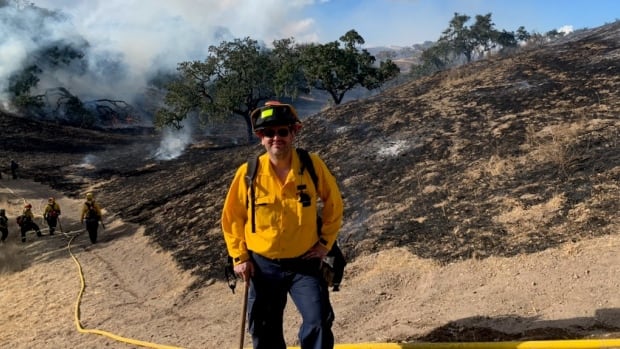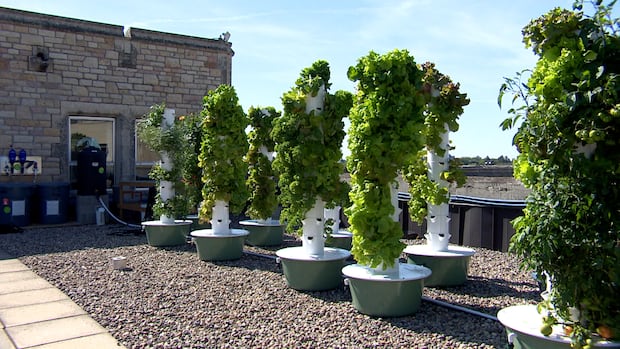Our planet is changing. So is our journalism. Keep up with the latest news on our Climate and Environment page.
Sign up here to get this newsletter in your inbox every Thursday.
This week:
- Fighting wildfires is evolving into a year-round job
- How geothermal heating works
- Rooftop garden adds fresh veggies to hospital meals
Wildfire season is getting longer in Canada. Should fighting fires be a year-round job?
When Dave Pascal began working as a forest firefighter, it was a three-months-a-year job. He spent the summers fighting wildfires, then went back to his regular job as a forest technician.
“It was like the little boys’ club. And we would just jump on helicopters, fly out into the bush, go and put fires out and come home and go back to our regular job,” he said.
But then, with climate change, the fire seasons kept getting longer — and so did Pascal’s work.
“All of a sudden, I don’t have another job anymore,” he said.
“Now, it’s a career.”
Climate change has changed almost every industry — and provided opportunities to rethink established practices. Pascal, a member of the Líl̓wat First Nation, is a cultural and prescribed fire specialist at the First Nations’ Emergency Services Society of British Columbia, where he’s bringing traditional Indigenous knowledge back to managing wildfire.
Communities across the province come to him with proposals for prescribed burns, which are controlled and planned burns to reduce the amount of fuel around their lands and make them safer during fire seasons.
“It’s their territory, it’s their land,” Pascal said.
“They know how to manage it. So they’ll tell me what their plan is, and I’m there to support their plan.”
The need for bringing back those practices is growing, especially after the historically bad 2023 fire season in Canada, and the devastating fires in Jasper this year.
That means greatly expanding the number of people working in this field, just like Canada needs more people to work in green retrofitting or to drill for geothermal energy. And like other parts of the green economy, that can mean changing the way the agencies fund these job positions and choose the people for them.
Amy Cardinal Christianson, a former research scientist at the Canadian Forest Service, advocates for more Indigenous wildland firefighters. She says the recruitment process requires a change to what some typically consider as “expertise,” especially when many Indigenous firefighters may not have had access to the usual degree programs and certificates for leadership positions in their field.
“They know their area, they know the values, they know how fire moves on the land, but they’re totally withheld from decision-making in their territories,” she said.
Along with changing that rigid template of who qualifies for certain jobs, stable funding from the government for year-round job security is also important to attract new people to the job, said Christianson.
“We need to stop thinking about fire as something that we can just throw money at in the summer and the problem will go away,” she said.
“What we’re seeing now with these summers of smoke is that it’s something that we need to invest in year round.”
– Inayat Singh

Old issues of What on Earth? are here. The CBC News climate page is here.
Check out our podcast and radio show. In our newest episode: Money from the oil and gas industry could be limiting the scope of climate solutions universities and other institutions dig into, according to a group of academics. They reviewed papers, news coverage and watchdog reports from around the world, including Canada, and say it’s time for more transparency about who is footing the bill and what the implications of industry involvement could be.
What On Earth21:23Meet the profs calling out fossil fuel funding in research
What On Earth drops new podcast episodes every Wednesday and Saturday. You can find them on your favourite podcast app, or on demand at CBC Listen. The radio show airs Sundays at 11 a.m., 11:30 a.m. in Newfoundland and Labrador.
Reader feedback
After last week’s article on the need for drillers to install climate-friendly geothermal (also called geoexchange) heating, we got a couple of emails from confused readers like Sherry Boschman. “I do know about geothermal but the way it is described in this article puzzles me,” she wrote.
The best way to explain is probably a diagram, so we’ve put one in The Big Picture below. But here are answers to some specific questions Sherry had:.
How deep do you have to drill? You need to drill below the frost line, and you need to be able to install enough pipe to exchange enough heat with the ground for the size of your building. In the Oakville development, the pipe was installed vertically (it can also be installed horizontally) and Diverso was drilling roughly 100 to 230 metres deep.
You mention installing pipes, but don’t you need to install a geothermal loop? Yes, the pipes are connected into a loop that collects heat from the ground and transfers it to a heat pump at one end. Water mixed with antifreeze circulates in the loop to absorb and carry the heat.
Where does the grout come in? Once the pipe is installed, the space surrounding it is filled with grout, both to plug the hole and to transfer the heat between the pipe and the ground. This is a technical detail that isn’t often mentioned in descriptions of geothermal heating.
As inflation and interest rates decline, are there personal investments in climate action that you’re thinking of taking?
Write us at whatonearth@cbc.ca.
Have a compelling personal story about climate change you want to share with CBC News? Pitch a First Person column here.

The Big Picture: How geothermal heating works
Geothermal (also known as geoexchange) heating and cooling is an efficient way to heat a home using electricity. It consists of a “geothermal loop” of pipes filled with water and antifreeze that circulates and exchanges heat with the ground. At one point, it passes through a ground-source heat pump, which pulls the heat into a building (for more detail on how a heat pump works, check out this diagram).
Below the frost line, the ground is a relatively constant temperature year round (about 10 C). That’s much warmer than the air in winter, which means a lot of heat can be easily harnessed by the heat pump, making ground-source heat pumps more efficient than air-source heat pumps.
After the heat is taken out of the water, it circulates back down through the loop to collect more heat from the ground.
In the summer, the system is reversed. The heat pump pulls heat out of the building and returns it to the ground to cool the home with air conditioning.
Geothermal heating and cooling can be either installed in individual buildings or as a network that serves many buildings. There is also a variation called lake or pond geothermal, where heat is exchanged with water instead of the ground.
— Emily Chung
Hot and bothered: Provocative ideas from around the web

Rooftop garden produces healthier hospital meals, with climate benefits

Patients and staff at Royal University Hospital in Saskatoon have a fresher option for vegetables at the hospital’s cafeteria these days.
That’s because the food is being grown six floors up, in a garden on top of the hospital’s roof.
Vanessa McCubbing, a Saskatchewan Health Authority employee who helped develop the garden, said the pilot project was created as a way to get locally sourced food into the hospital for patients and staff.
“Rooftops are generally unused spaces,” said McCubbing. “We thought it was a really fun opportunity to grow local food.”
The food in the garden — which was planted in July — is grown in aeroponic towers. The plants’ roots sit in a tub-like structure and are sprayed with a nutrient-rich mist to help them grow.
The Royal University Hospital in Saskatoon is growing fresh vegetables for the cafeteria in aeroponic towers on the building’s roof.
McCubbing said more than 70 kilograms (around 160 pounds) of produce have been used in the hospital’s cafeteria through the project so far.
“It’s pretty low-maintenance — no weeding, which is great, low labour, very ergonomic,” she said.
Melanie Marushechka, a food services employee at the hospital, has been hard at work this summer growing and harvesting the food, which has mainly included lettuce, herbs and tomatoes.
“We look at our menu options that we’re serving in the cafeteria for today as well as tomorrow, and we come up and harvest the things that would go along with those menu items,” she said.

From there, the vegetables are used for salads in the cafeteria, or as side items for meals delivered to patients.
Marushechka said the garden is also pesticide-free, which is ideal for patients who can’t tolerate food sprayed with chemicals.
The garden, she said, has attracted attention from hospital patrons.
“They’re shocked that we’re growing something here on the roof,” she said. “It’s sparking their mind as to how to grow things, how to be sustainable here in Saskatoon.”
Wanda Martin, an associate professor in the college of nursing at the University of Saskatchewan, said the project helps people connect with where their food is coming from.
“When you’re eating food that really looks good and is really fresh, you’re more willing to consume it,” said Martin. “So it enhances your opportunity for well-being when you’re a patient in the hospital.”

Martin said local food is important as climate change continues to impact growing conditions around the world.
“As [other growing regions] get warmer and there’s opportunities for food systems to fail, having localized food systems … can prevent some challenges in the future.”
Rooftop gardens, said Martin, can also reduce the carbon footprint of a building.
Asphalt roofs generate a considerable amount of heat, but plants can trap the heat and use it to grow.
Martin herself has been part of the work around the garden. She hopes with enough funding, a feasibility study can be done to see if a greenhouse could be built on the roof to keep the garden running year-round and provide food to the wider community.
The project will wind down with this year’s growing season, and the aeroponic towers will be placed into storage for the winter.
If it’s continued next year, staff hope to experiment with other crops such as strawberries and continue to grow flowers that were planted this year to add some colour to the garden.
“Food matters — food is medicine,” said McCubbing. “Having that involvement in being able to produce food that is consumed within the health-care system is really rewarding.”
— Ethan Williams
Stay in touch!
Thanks for reading. Are there issues you’d like us to cover? Questions you want answered? Do you just want to share a kind word? We’d love to hear from you. Email us at whatonearth@cbc.ca.
Sign up here to get What on Earth? in your inbox every Thursday.
Editors: Emily Chung and Hannah Hoag | Logo design: Sködt McNalty



